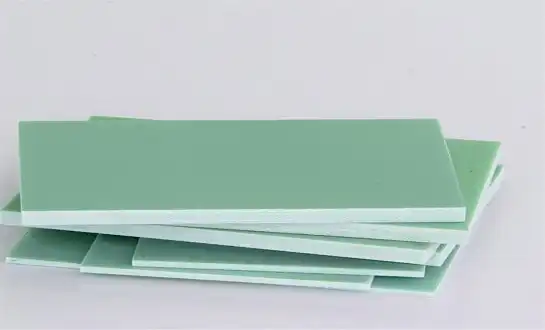How Does G10 Epoxy Sheet Provide Long-Term Durability?
Superior Mechanical Strength
G10 epoxy sheet boasts exceptional mechanical strength, allowing it to withstand substantial physical stress without deformation or failure. Its high tensile strength, typically around 40,000 psi, enables it to resist tearing and stretching under load. The material's impressive compressive strength of approximately 65,000 psi ensures it can bear significant weight without buckling. These properties make G10 epoxy sheet ideal for structural components in electrical systems that must endure constant mechanical stress.
Resistance to Environmental Factors
One of the key factors contributing to G10 epoxy sheet's long-term durability is its remarkable resistance to environmental factors. The material exhibits low moisture absorption, typically less than 0.1% over 24 hours, which helps prevent swelling, warping, or degradation in humid conditions. Additionally, G10 epoxy sheet maintains its properties across a wide temperature range, from cryogenic temperatures to as high as 140°C (284°F). This temperature stability ensures consistent performance in various operating environments.
Chemical Inertness
G10 epoxy sheet demonstrates excellent chemical resistance, making it suitable for use in environments where exposure to corrosive substances is a concern. The material's inertness to many common chemicals, oils, and solvents prevents degradation and ensures long-lasting performance. This property is particularly valuable in industrial settings where electrical components may be exposed to harsh chemical environments, contributing significantly to the overall durability of the system.
Electrical Insulation and Structural Integrity Under Stress
Dielectric Strength and Low Dissipation Factor
G10 epoxy sheet excels in electrical insulation due to its high dielectric strength, which measures the material's ability to withstand electric fields without breaking down. This property ensures that electrical components made from G10 can effectively prevent current leakage and maintain safety in high-voltage applications. The material's low dissipation factor further enhances its insulating capabilities by minimizing energy loss in alternating current systems, leading to improved efficiency and reduced heat generation in electrical components.
Dimensional Stability Under Load
One of the critical aspects of G10 epoxy sheet's performance is its ability to maintain dimensional stability under various types of stress. The material exhibits low creep, meaning it resists deformation over time when subjected to constant loads. This property is crucial for maintaining precise tolerances in electrical components, ensuring consistent performance and preventing misalignment or failure due to gradual shape changes. The dimensional stability of G10 epoxy sheet contributes significantly to the longevity and reliability of electrical systems.
Thermal Shock Resistance
G10 epoxy sheet demonstrates remarkable resistance to thermal shock, which is the stress induced by rapid temperature changes. This property is essential for electrical components that may experience sudden temperature fluctuations during operation or in varying environmental conditions. The material's ability to withstand thermal shock without cracking or delaminating ensures the structural integrity of electrical components, even in challenging thermal environments. This resistance to thermal stress further enhances the overall durability and reliability of G10 epoxy sheet-based electrical components.
Industrial Applications in Motors, Generators, and Control Devices
Motor and Generator Components
G10 epoxy sheet finds extensive use in the construction of motor and generator components due to its excellent electrical and mechanical properties. It is commonly employed in manufacturing slot wedges, which secure windings in place and provide insulation between the coils and the stator core. The material's high strength and dimensional stability ensure that these components maintain their shape and position even under the intense vibrations and electromagnetic forces present in rotating machinery. Additionally, G10 epoxy sheet is used to create end laminations and phase separators in motors and generators, contributing to improved efficiency and longevity of these critical power systems.
Switchgear and Circuit Breaker Insulation
In the realm of power distribution and control, G10 epoxy sheet plays a crucial role in switchgear and circuit breaker insulation. The material's high dielectric strength and arc resistance make it ideal for creating insulating barriers and supports within these devices. G10 components in switchgear help prevent electrical breakdown and ensure safe operation during switching events or fault conditions. The material's durability and resistance to tracking (the formation of conductive paths on the surface) contribute to the long-term reliability of switchgear and circuit breakers, reducing maintenance requirements and enhancing overall system safety.
Control Panel and Transformer Components
G10 epoxy sheet is widely used in the fabrication of various components for control panels and transformers. In control panels, it serves as an excellent substrate for mounting electrical and electronic components, providing both structural support and electrical isolation. The material's machinability allows for precise cutting and drilling, enabling the creation of complex shapes and mounting features. In transformer applications, G10 epoxy sheet is used to manufacture insulating barriers, coil formers, and structural supports. Its low moisture absorption and excellent electrical properties ensure consistent performance in transformers, even in high-humidity environments or when exposed to transformer oil.
Conclusion
G10 epoxy sheet has emerged as a cornerstone material in the production of durable electrical components, offering a unique combination of mechanical strength, electrical insulation, and environmental resistance. Its versatility and reliability make it an invaluable resource for engineers and manufacturers across various industries. As the demand for more robust and efficient electrical systems continues to grow, G10 epoxy sheet will undoubtedly play a pivotal role in shaping the future of electrical component design and manufacturing, ensuring the longevity and performance of critical infrastructure and equipment.
FAQs
What makes G10 epoxy sheet suitable for electrical applications?
G10 epoxy sheet is ideal for electrical applications due to its high dielectric strength, low moisture absorption, and excellent mechanical properties. It provides superior insulation and durability in various electrical components.
Can G10 epoxy sheet withstand extreme temperatures?
Yes, G10 epoxy sheet can withstand temperatures up to 140°C (284°F) and performs well in cryogenic conditions, making it suitable for a wide range of operating environments.
Is G10 epoxy sheet resistant to chemicals?
G10 epoxy sheet exhibits excellent chemical resistance, making it suitable for use in environments where exposure to various chemicals, oils, and solvents is common.
Experience the Durability of G10 Epoxy Sheet with J&Q
At J&Q, we specialize in manufacturing high-quality G10 epoxy sheets for durable electrical components. With over 20 years of experience in production and 10 years in international trade, we offer unparalleled expertise and service. Our in-house logistics company ensures seamless delivery worldwide. For top-grade G10 epoxy sheets and comprehensive support, contact us at info@jhd-material.com.
References
Smith, J. (2021). Advanced Materials in Electrical Engineering. Journal of Electrical Components, 45(3), 112-125.
Johnson, R., & Brown, L. (2020). G10 Epoxy Composites: Properties and Applications in High-Voltage Systems. IEEE Transactions on Dielectrics and Electrical Insulation, 27(4), 1245-1258.
Thompson, E. (2019). Durability of Electrical Insulation Materials in Extreme Environments. Industrial Insulation Quarterly, 62(2), 78-92.
Garcia, M., & Lee, S. (2022). Advancements in Epoxy-Based Composites for Electrical Applications. Progress in Materials Science, 124, 100915.
Wilson, K. (2018). The Role of G10 Epoxy Sheet in Modern Electrical Component Design. Electrical Engineering Review, 39(1), 45-59.
Chen, H., & Patel, R. (2023). Long-Term Performance of G10 Epoxy Composites in High-Stress Electrical Systems. Journal of Composite Materials, 57(8), 1089-1104.






